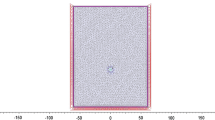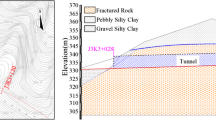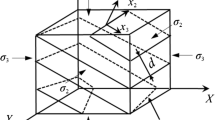Abstract
With the increase in the pace of development, the demand for tunnels has increased in recent years. Analysing the stability of a tunnel in a fractured rock mass is a very challenging and cumbersome activity. The tunnel stability depends on the strength of the rock, joints bolt strength, in-situ stresses, and their orientation. This paper focuses on constructing tunnels in fractured/jointed rock mass. Three different software namely Rocscience Phase2 (finite element based), FLAC3D (finite volume based) and PFC3D (distinct element based), were used to analyse the performance and stability under static and dynamic loading conditions. The geomaterial properties used for the analysis were taken from data obtained after laboratory testing and based on available literature. The effect of joint orientation and bolt length was analysed using Phase 2 assuming plain strain conditions. The effect of earthquake and performance of fully grouted, energy absorbing and deformation-controlled bolts under seismic loading conditions were compared using FLAC3D. While the 3D distinct element analysis of geometry was performed using PFC3D to evaluate the effect of joints and their orientation. The performance of the different types of bolts was also analysed numerically. The behaviour of bolts can be customised using the ‘fish‘function. The results indicate that analysis must incorporate the fusion of various numerical simulation techniques like finite element-, finite volume- and distinct element-based methods for more reliable results.
Similar content being viewed by others
References
Barton, N., and Choubey, V. (1977) The shear strength of rock joints in theory and practice. Rock Mech., v.10(1), pp.1–54.
Barton, N.R. (1986) Deformation phenomena in jointed rock. Géotechnique, v.36(2), pp.147–167. doi:https://doi.org/10.1680/geot.1986.36.2.147
Cai, M., Kaiser, P.K., Tasaka, Y. and Minami, M. (2007) Determination of residual strength parameters ofjointed rock masses using the GSI system. Internat. Jour. Rock Mech. Min. Sci., v.44(2), pp.247–265. doi:https://doi.org/10.1016/j.ijrmms.2006.07.005
Carranza-Torres, C. (2009) Analytical and Numerical Study of the Mechanics of Rockbolt Reinforcement around Tunnels in Rock Masses. Rock Mech. Rock Eng., v.42(2), pp.175–228. doi:https://doi.org/10.1007/s00603-009-0178-2
Chen, L., Wu, S., Jin, A. and Li, X. (2021) The evolution regularity and influence factor analysis of zonal disintegration around deep jointed rock mass: a numerical study based on DEM. Bull. Eng. Geol. Environ., v.81(1), pp.37. doi:https://doi.org/10.1007/s10064-021-02530-w
Das, R. and Singh, T.N. (2021) Effect of Closely Spaced, Non-Persistent Ubiquitous Joint on Tunnel Boundary Deformation: A Case Study from Himachal Himalaya. Geotech. Geol. Eng., v.39(3), pp.2447–2459. doi:https://doi.org/10.1007/s10706-020-01637-3
Das, R. and Singh, T.N. (2021) Effect of rock bolt support mechanism on tunnel deformation in jointed rockmass: A numerical approach. Underground Space, v.6(4), pp.409–420. doi:https://doi.org/10.1016/j.undsp.2020.06.001
Fan, X., Kulatilake, P.H.S.W. and Chen, X. (2015) Mechanical behavior of rock-like jointed blocks with multi-non-persistent joints under uniaxial loading: A particle mechanics approach. Eng. Geol., v.190, pp.17–32. doi:https://doi.org/10.1016/j.enggeo.2015.02.008
Goodman, R. E. (1995) Block theory and its application. Géotechnique, v.45(3), 383–423. doi:https://doi.org/10.1680/geot.1995.45.3.383
Goodman, R.E. and Shi, G. (1985) Block theory and its application to rock engineering. Prentice Hall, Englewood Cliffs, NJ. https://www.osti.gov/biblio/5649281
Gupta, V., Bhasin, R.K., Kaynia, A.M., Kumar, V., Saini, A.S., Tandon, R.S. and Pabst, T. (2016) Finite element analysis of failed slope by shear strength reduction technique: a case study for Surabhi Resort Landslide, Mussoorie township, Garhwal Himalaya. Geomatics, Natural Hazards and Risk, v.7(5), pp.1677–1690. doi:https://doi.org/10.1080/19475705.2015.1102778
Hammah, R.E., Yacoub, T.E., Corkum, B.C. and Curran, J.H. (2005) The Shear Strength Reduction Method for the Generalized Hoek-Brown Criterion. Alaska Rocks 2005, The 40th U.S. Symposium on Rock Mechanics (USRMS)
Hoek, E. and Brown, E.T. (2019). The Hoek-Brown failure criterion and GSI–2018 edition. Jour. Rock Mech. Geotech. Eng., v.11(3), pp.445–463. doi:https://doi.org/10.1016/j.jrmge.2018.08.001
Hoek, E., Carranza-Torres, C. and Corkum, B. (2002) Hoek-Brown failure criterion-2002 edition. Proc. NARMS-Tac, v.1(1), pp.267–273.
Hoek, E., Wood, D. and Shah, S. (1992) A modified Hoek-Brown failure criterion for jointed rock masses. In: Rock Characterization: ISRM Symposium, Eurock’ 92, Chester, UK, 14–17 September 1992, pp.209–214. doi:https://doi.org/10.1680/rc.35621.0037
Itasca Consulting Group, I. (2017) FLAC3D-fast Lagrangian analysis of continua in three-dimensions, Ver. 6.0. In Itasca Minneapolis.
Itasca Consulting Group, I. (2018) PFC3D-Particle Flow Code, Ver. 6.0. In Itasca Minneapolis.
Jana, A., Pushpan, M., Dey, A., Sreedeep, S. and Murali Krishna, A. (2019) Static and Dynamic Slope Stability Assessment of a Himalayan Rock Slope. Geotechnical Applications, Singapore.
Jia, P. and Tang, C.A. (2008) Numerical study on failure mechanism of tunnel in jointed rock mass. Tunnelling and Underground Space Tech., pp.23(5), pp.500–507. doi:https://doi.org/10.1016/j.tust.2007.09.001
Jiang, M., Shen, Z. and Wang, J. (2015) A novel three-dimensional contact model for granulates incorporating rolling and twisting resistances. Computers and Geotechnics, v.65, pp.147–163. doi:https://doi.org/10.1016/j.compgeo.2014.12.011
Kainthola, A., Singh, P.K., Verma, D., Singh, R., Sarkar, K. and Singh, T.N. (2015) Prediction of Strength Parameters of Himalayan Rocks: A Statistical and ANFIS Approach. Geotec. Geol. Eng., v.33(5), pp.1255–1278. doi:https://doi.org/10.1007/s10706-015-9899-z
Kanungo, D.P., Pain, A. and Sharma, S. (2013) Finite element modeling approach to assess the stability of debris and rock slopes: a case study from the Indian Himalayas. Natural Hazards, v.69(1), pp.1–24. doi:https://doi.org/10.1007/s11069-013-0680-4
Kumar, N., Varughese, A., Kapoor, V. and Dhawan, A. (2004) In situ stress measurement and its application for hydro-electric projects—an Indian experience in the Himalayas. Internat. Jour. Rock Mech. Min. Sci., v.41, 195–200.
Latha Gali, M. and Garaga, A. (2010) Stability analysis of a rock slope in Himalayas. Geomech. Eng., v.2(2), pp.125–140. doi:https://doi.org/10.12989/GAE.2010.2.2.125
Latha, G.M. anf Garaga, A. (2010) Seismic Stability Analysis of a Himalayan Rock Slope. Rock Mech. Rock Eng., v.43(6), pp.831–843. doi:https://doi.org/10.1007/s00603-010-0088-3
Madkour, H. (2012) Parametric analysis of tunnel behavior in jointed rock. Ain Shams Engineering Journal, v.3(2), pp.79–103. doi:https://doi.org/10.1016/j.asej.2012.01.002
Mahanta, B., Singh, H.O., Singh, P.K., Kainthola, A. and Singh, T.N. (2016) Stability analysis of potential failure zones along NH-305, India. Natural Hazards, v.83(3), pp.1341–1357. doi:https://doi.org/10.1007/s11069-016-2396-8
Mánica, M., Ovando, E. and Botero, E. (2014) Assessment of damping models in FLAC. Computers and Geotechnics, v.59, pp.12–20. doi:https://doi.org/10.1016/j.compgeo.2014.02.007
Mortazavi, A. and Tabatabaei Alavi, F. (2013) A numerical study of the behavior of fully grouted rockbolts under dynamic loading. Soil Dynam. Earthquake Eng., v.54, pp.66–72. doi:https://doi.org/10.1016/j.soildyn.2013.08.003
Pain, A., Kanungo, D. P. anf Sarkar, S. (2014) Rock slope stability assessment using finite element based modelling - examples from the Indian Himalayas. Geomech. Geoeng., v.9(3), pp.215–230. doi:https://doi.org/10.1080/17486025.2014.883465
Pal, S., Kaynia, A.M., Bhasin, R.K. and Paul, D.K. (2012) Earthquake Stability Analysis of Rock Slopes: a Case Study. Rock Mech. Rock Eng., v.45(2), pp.205–215. doi:https://doi.org/10.1007/s00603-011-0145-6
Pandit, K., Sarkar, S., Samanta, M. anf Sharma, M. (2016). Stability analysis and design of slope reinforcement techniques for a Himalayan landslide. Proc. Conference on Recent Advances in Rock Engineering (RARE 2016)
Ray, A., Rai, R. and Singh, T. (2022) The effect of discontinuity orientation and thickness of the weathered layer on the stability of lesser himalayan rock slope. Jour. Geol. Soc. India, v.98(2), pp.260–270. doi:https://doi.org/10.1007/s12594-022-1966-5
Rocscience, I. (2016). Phase2 v.8, 2D Finite Element Software. In: https://www.rocscience.com
Russo, G., Kalamaras, G. and Grasso, P. (1998) A discussion on the concepts of geomechanical classes behavior categories and technical classes for an underground project. Gallerie e grandi opere sotterranee, v.54, pp.40–51.
Schnabel, P.B. (1973) Effects of local geology and distance from source on earthquake ground motions University of California, Berkeley.
Siddique, T., Pradhan, S.P., Vishal, V., Mondal, M.E.A. and Singh, T.N. (2017) Stability assessment of Himalayan road cut slopes along National Highway 58, India. Environ. Earth Sci., v.76(22), pp.759. doi:https://doi.org/10.1007/s12665-017-7091-x
Siddque, T. and Pradhan, S.P. (2018) Stability and sensitivity analysis of Himalayan road cut debris slopes: an investigation along NH-58, India. Natural Hazards, v.93(2), pp.577–600. doi:https://doi.org/10.1007/s11069-018-3317-9
Singh, P., Kainthola, A. and Singh, T. (2015) Risk analysis of High Hill Slopes—a case history. Jour. Rock Mech. Tunnel. Tech., v.21(2), pp.101–113.
Tiwari, G. and Latha, G. M. (2019) Reliability analysis of jointed rock slope considering uncertainty in peak and residual strength parameters. Bull, Eng. Geol. Environ., v.78(2), pp.913–930. doi:https://doi.org/10.1007/s10064-017-1141-1
Xing, Y., Kulatilake, P.H.S.W. and Sandbak, L.A. (2018) Effect of rock mass and discontinuity mechanical properties and delayed rock supporting on tunnel stability in an underground mine. Eng. Geol., v.238, pp.62–75. doi:https://doi.org/10.1016/j.enggeo.2018.03.010
Yokota, Y., Zhao, Z., Nie, W., Date, K., Iwano, K., Koizumi, Y. and Okada, Y (2020) Development of a new deformation-controlled rock bolt: Numerical modelling and laboratory verification. Tunnelling and Underground Space Technology, v.98, 103305. doi:https://doi.org/10.1016/j.tust.2020.103305
Zhu, Z., Li, Y., Xie, J. and Liu, B. (2015) The effect of principal stress orientation on tunnel stability. Tunnelling and Underground Space Technology, v. 49, pp.279–286. doi:https://doi.org/10.1016/j.tust.2015.05.009
Acknowledgement
The authors acknowledge accessing strong-motion data through the Centre for Engineering Strong Motion Data (CESMD), last visited on 18 Aug 2021. The networks or agencies providing the data used in this report are the California Strong Motion Instrumentation Program, the USGS National Strong Motion Project and the Indian Institute of Technology (IIT), Roorkee. The authors also acknowledge the Department of Earthquake engineering, IIT Roorkee for their support to conduct this research.
Author information
Authors and Affiliations
Corresponding author
Additional information
Harshal Verma is currently Research Scholar at the Civil Engineering Department of IIT Delhi. His research interest includes slope stability analysis, ground improvement and stability of underground excavations. He has performed the numerical analysis and written the first draft of the manuscript.
Rajesh Rai is currently Associate Professor at the Department of Mining Engineering, IIT BHU, Varanasi. His research interest includes rock mechanics and slope stability. He has revised the drafted manuscript and offered valuable comments.
T. N. Singh is currently Director IIT Patna and Professor at Department of Earth Sciences IIT Bombay. His research interest includes rock mechanics, artificial intelligence, engineering geology and mining rock engineering. He has revised the drafted manuscript, suggested valuable comments, and approved the final manuscript.
Arunava Ray is an Assistant Professor at the Centre for Disaster Mitigation and Management, VIT Vellore. His research interest includes slope stability analysis, post failure debris flow and ground improvement in slopes. He has performed the numerical analysis and written the first draft of the manuscript.
Bappaditya Manna is Professor at the Civil Engineering Department of IIT Delhi. His research interest includes designing of deep foundations and vibration isolation system of railway track for high-speed trains and underground metros. He has revised the drafted manuscript and suggested valuable comments.
Rights and permissions
About this article
Cite this article
Verma, H., Ray, A., Rai, R. et al. Numerical Analysis of a Tunnel Passing through Jointed Rockmass. J Geol Soc India 99, 1683–1694 (2023). https://doi.org/10.1007/s12594-023-2524-5
Received:
Accepted:
Published:
Issue Date:
DOI: https://doi.org/10.1007/s12594-023-2524-5




